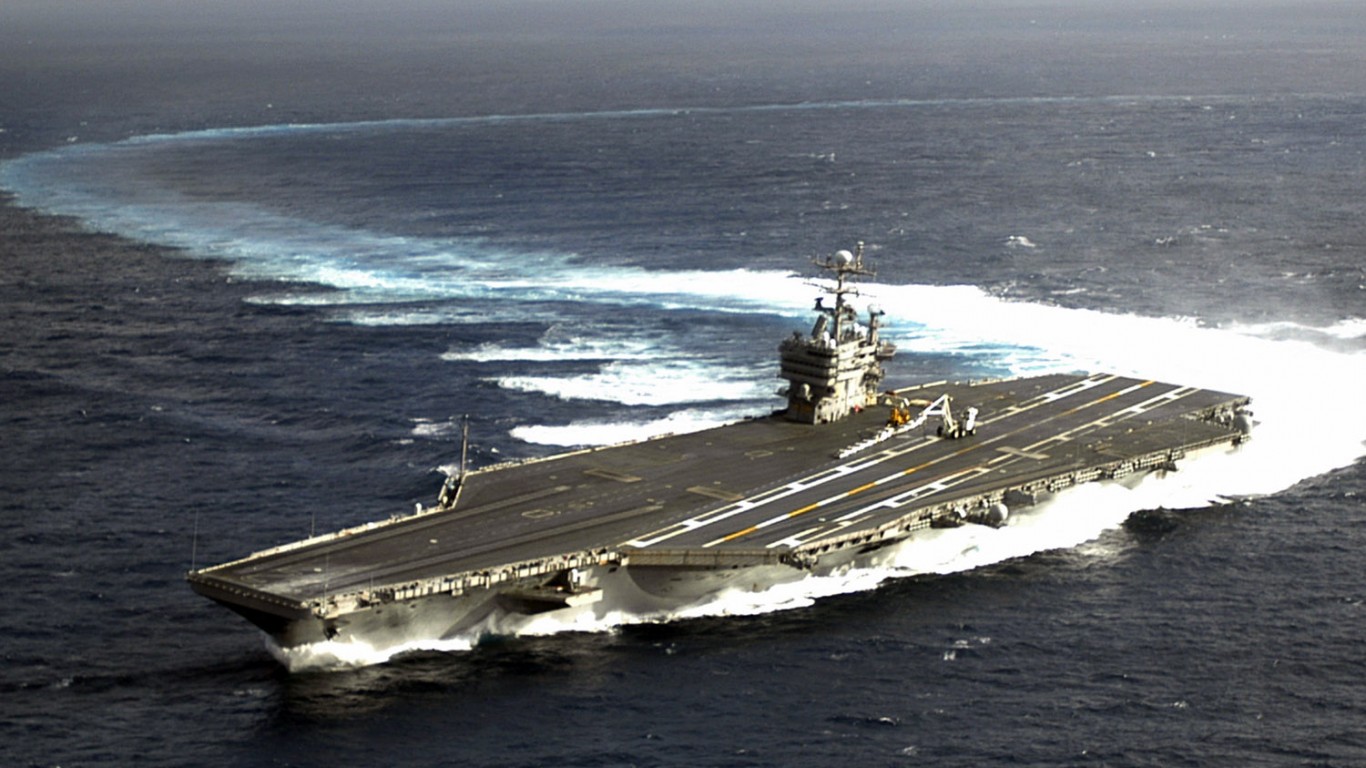
In the 10 years between 2011 and 2020, the U.S. Department of Defense budget will rise by about 15.6%, from $855.1 billion to an estimated $989 billion. The total includes $218 billion to fund the Department of Veterans Affairs. In military spending alone, the 2020 budget is likely to fall in a range of $733 billion to $750 billion.
In 2018, obligated funds for the Defense Department totaled about $229 billion spread across 100 top contractors and included federal government purchases of everything from aircraft carriers to paper clips. Total military spending last year was about $649 billion.
Last year’s top military suppliers were Lockheed Martin ($38.93 billion obligated), Boeing ($27.49 billion), Raytheon ($18.12 billion), General Dynamics ($14.27 billion) and Northrop Grumman ($10.79 billion). These five accounted for nearly $110 billion in funding last year, or about 30% of all defense spending in 2018.
Not all U.S. arms makers’ revenue comes from supplying defense and weapons systems to the U.S. government. Sales to foreign governments in 2017 totaled more than $3 billion, according to data reported by the Stockholm International Peace Research Institute. According to institute data, the United States ($649.0 billion), China ($250.0 billion), Saudi Arabia ($67.6 billion), India ($61.4 billion) and France ($63.8 billion) are responsible for about 60% of global spending on defense. The United States alone accounts for nearly 36% of the world’s total spending on defense.
Under the Trump administration, defense contractors have grown handsomely, easily beating the S&P 500 index with a two-year rise of nearly 37% to the index’s 22% gain. Adding in the safety of exchange-traded funds (ETFs) that spread investments among many dozens of companies, aerospace and defense funds can be a good choice. The constraint is that there is just a handful to choose from.
The iShares U.S. Aerospace & Defense ETF (ITA) is a non-diversified fund that seeks to track the results of the Dow Jones U.S. Select Aerospace & Defense Index. Assets under management total $5.02 billion, and 99% of the fund’s 35 holdings are equities industrial corporations. The fund’s top five holdings are Boeing, United Technologies (UTC), Lockheed Martin and TransDigm. These five stocks account for more than 48% of the fund’s assets.
The net asset value of the fund at the May 3 close was $211.23 per share, with 25 million shares outstanding. The 52-week range is $160.29 to $218.83. The fund was established in May 2006 and has an expense ratio of 0.43%. Since its inception, the fund has posted a total return of 12.46%, and over the past 10 years, the total return is 21.04%. Since the beginning of the year, the fund is up about 15.7%.
The SPDR S&P Aerospace & Defense ETF (NYSEARCA: XAR) is five-years younger than the iShares ITA fund and, with $1.03 billion in assets under management, about 80% smaller. The fund seeks to match the results of the S&P Aerospace & Defense Select Industry Index and holds 32 equities, 100% of which are industrial stocks. The top five holdings are Axon Enterprise, Arconic, HEICO, UTC and TransDigm. Together they account for more than 22% of the fund’s total assets.
The net asset value of the fund at the May 3 close was $98.33 per share, with 14 million shares outstanding. The 52-week range is $73.23 to $101.22. The fund was established in September 2011 and has an expense ratio of 0.35%. Since its inception, the fund has posted a return of 20.72% (as of March 31) and over the past five years, the total return is 13.92%. Since the beginning of the year, the fund is up about 16.5%.
The Invesco Aerospace & Defense ETF (NYSEARCA: PPA) has about $846.6 million in assets under management and seeks to track the results of the SPADE Defense Index. Of the fund’s 49 equities, 83% are industrial companies, 12% are technology firms and 4% are basic materials firms. The top five holdings are Lockheed Martin, UTC, Honeywell, Boeing and General Dynamics. These stocks account for about 34% of the fund’s total assets.
The net asset value of the fund at the May 3 close was $62.47 per share, with 15.15 million shares outstanding. The 52-week range is $45.98 to $62.68. The fund was established in October 2005 and has an expense ratio of 0.60%. Since its inception, the fund has posted a return of 11.81%, and over the past 10 years, the total return is 18.68%. Since the beginning of the year, the fund is up about 17.38%.
The Direxion Daily Aerospace & Defense Bull 3X Shares Direxion Daily Aerospace (NYSEARCA: DFEN) fund has about $57 million in assets under management and seeks daily results equal to 300% of the daily performance of the Dow Jones U.S. Select Aerospace & Defense Index. Of the fund’s 35 holdings, 98% are aerospace and defense equities. The top five holdings are Boeing, UTC, Lockheed Martin, TransDigm and General Dynamics, which account for about 54% of the fund’s assets.
The net asset value of the fund at the May 3 close was $51.94 per share, with 1.2 million shares outstanding. The 52-week range is $23.89 to $64.50. The fund was established in May 2017 and has an expense ratio of 1.0%. Since its inception, the fund has posted a return of 44.59%. Since the beginning of the year, the fund is up about 71.91%.
Take This Retirement Quiz To Get Matched With An Advisor Now (Sponsored)
Are you ready for retirement? Planning for retirement can be overwhelming, that’s why it could be a good idea to speak to a fiduciary financial advisor about your goals today.
Start by taking this retirement quiz right here from SmartAsset that will match you with up to 3 financial advisors that serve your area and beyond in 5 minutes. Smart Asset is now matching over 50,000 people a month.
Click here now to get started.
Thank you for reading! Have some feedback for us?
Contact the 24/7 Wall St. editorial team.
 24/7 Wall St.
24/7 Wall St.